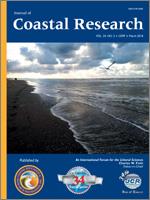Chen, C.; Melville, B.W.; Nandasena, N.A.K., and Farvizi, F., 2018. An experimental investigation of tsunami bore impacts on a coastal bridge model with different contraction ratios.
Tsunamis are natural hazards that have damaged many coastal bridges worldwide in recent years. As a contribution to an important area of coastal research, this study investigated tsunami bore impact on a bridge model with different contraction ratios. The time histories of the horizontal force, vertical force, and overturning moment on a deck-pier structure in a tsunami flume were measured by a load cell at the base of the structure. Results show that different stages of the flow motion were observed during the bore-bridge interactions. The time histories of tsunami loads on deck-pier structures reveal that the horizontal force was characterized by four stages, the vertical force was characterized by three stages, and the overturning moment was characterized by four stages. The maximum upward force and the maximum overturning moment occurred at the same time in the splashing stage. The maximum horizontal force occurred in the water-accumulation stage. The maximum downward force occurred in the recession stage. Tsunami loads increased with increasing bore strength, and for most bore strengths, the effects of the contraction ratio on tsunami loads were different for horizontal force, vertical force, and overturning moment. Finally, on the basis of experimental data, equations for estimating tsunami loads are proposed as functions of the bore height and the contraction ratio.





